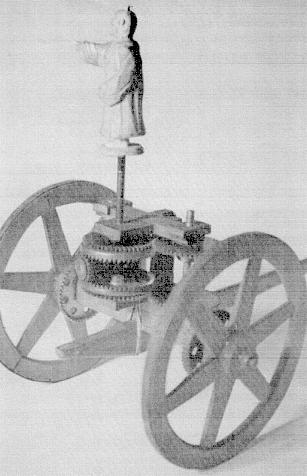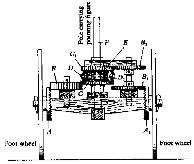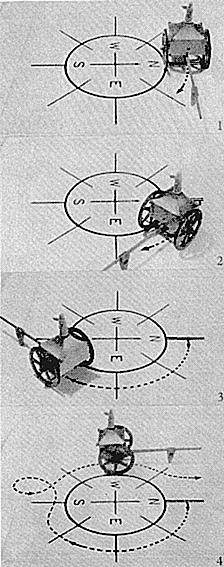Lanchester's Hypothesis
| Mr. George H. Lanchester, former chief engineer of Lanchester Cars,
1932 proposed the completely different arrangement shown to the right. His
aim was to avoid the engage-disengage procedure by using an all-geared,
constantly enmeshed, full-fledged differential. But to satisfy the specification
given in the Sung Shih many "misprints"
(e.g. number of gears, total number of teeth) have to be assumed.
Alternatively, deliberately wrong details may be assumed, intended
to keep the design secret.
Another problem would be accuracy: It is left as an exercise to the
reader to calculate the directional deviation resulting from a mismatch
of only one percent in the diameters of the road wheels.
|
(click for details)
rear view
|
The function is described as follows:
The gears A, A1 fixed to the road-wheels engage with horizontal
intermediate wheels B, B1 (extended to B2), but these
are now so arranged as to be permanently in gear with an upper and a lower
bevelled wheel C1, C, the upper one of which is concentric with
the shaft carrying the pointing figure but is not fixed to it. Between
them run two small idling wheels D, D1 connected by a stub-shaft
E from the centre of which rises up at right angles the shaft F carrying
the pointing figure. Relative motions of the road-wheels will now be accurately,
and inversely, reflected in the movements of the idling wheels and the pointer
which they carry.
If, for instance, the left-hand road-wheel moves faster than the right,
as on a westward turn, B will move while B1, B2 will
be almost stationary, and C will be turning while C1 will be
almost at rest. Hence D, D1 will react to precisely the same extent
but in the opposite direction. They will then stay put, though C, C1
will resume their mutually opposite regular motion until further relative
change of the road-wheel velocities occurs.
The proof of the pudding...
| Mr.Lanchester built a scale model of his design (using
wood and only a pen knife !) and demonstrated its functionality on many occasions
(so I've been told by contemporaries)

|
|
Needham's original model seems to have survived in the Science Museum in London. Pictures can be ordered from there,
the order codes are NAVC100036 and NAVC100037.
Source: Needham. Joseph: Science and
Civilization in China, Volume 4, Part II, 1965


